The success of a call center hinges on different elements: positive customer experience, well-equipped service representatives, goal-driven metrics, and the right software solution. When you hit these crucial factors, you attract and retain your most important stakeholders: the clients and agents.
To ensure you have these winning elements, adopt call center best practices such as listening actively to customers’ concerns, conducting training regularly, and investing in robust call center systems. Read on to learn more strategies.
Improving the Customer Experience
High customer satisfaction is a top priority of call center teams, as it directly affects brand loyalty, customer retention, and company reputation and profitability. To improve customer service, your team must focus on three aspects: speedy resolution, competent service, and friendly agents. With these core principles in mind, apply these call center best practices:
1. Exercise Active Listening
Active listening involves focusing on what the customer is saying to understand their needs and questions clearly. Here are some ways to practice this:
- Repeat and paraphrase customer concerns: This allows you to gauge if you grasped what customers said accurately, and more importantly, reassures them that you’re paying attention.
- Be familiar with possible distractions in your work environment: These may include opened apps on your computer and agent chatter. When you’re aware of what distracts you, you’ll know how to adjust and reduce their impact while taking calls.
- Be in the moment: Concentrate on what the customer is saying, instead of being fixated on what to answer. The solutions follow naturally when you understand the customer’s needs well.
2. Be Polite & Patient
Use “please” and “thank you” to create a welcoming, friendly atmosphere in the phone conversation. When customers talk about a frustrating experience, acknowledge their emotions and express empathy. Some statements included in call center script best practices are:
- “I completely understand your frustration…”
- “What you went through is indeed unacceptable…”
- “I’m sorry to hear about your experience…”
On top of being polite, exercise patience. Don’t interrupt customers when they share concerns. More importantly, restrain yourself from being worked up when callers lash out. Take deep breaths before answering and remember that customers are frustrated about the situation, not at you.
3. Shorten Hold Times
Being placed on hold for a long period causes customer dissatisfaction. Reduce hold times by providing a callback option and considering adding more representatives during peak periods. If possible, introduce other customer service channels, like email, web chat, and social media. An omnichannel approach not only shortens hold times but also reduces the number of phone calls coming through the system.
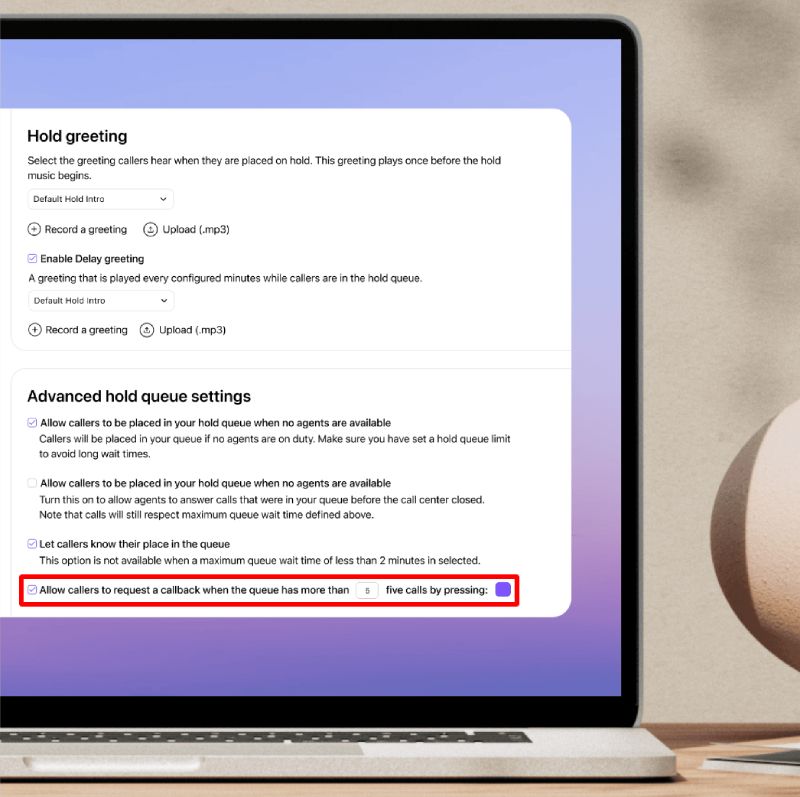
Dialpad allows users to toggle on scheduled callback. (Source: Dialpad)
In its advanced hold queue settings, Dialpad Contact Center lets admins give callers the option to request a callback to shorten phone lines. The customer waiting in the queue hears a message about the callback, directing them to press a specific number if they don’t want to wait in line and wish to be called back instead.
When they press the number, a callback confirmation message will play and the call will end. The caller’s position in the queue is saved for them. Once they reach the front of the line, Dialpad automatically calls their phone number. Its monthly subscription plan starts at $95 per user.
4. Collect Customer Feedback
One of the call center management best practices is conducting voice of the customer (VoC) research. This effectively determines which areas need to be improved to enhance customer satisfaction. Use the following methodologies to gather feedback:
- Survey: Send a poll after every phone call or transaction. Keep them brief, as short surveys have higher completion rates than long ones. If you need to send an in-depth survey, provide incentives to respondents to encourage completion.
- Interview: When a customer talks about an issue they encountered with a product or service, ask probing questions directly. Although interviews are time-intensive, the insights you’ll gather are highly valuable since they allow you to ask follow-up questions for more clarity.
- Social media: Check the common questions and frustrations customers leave on your social media pages. Compile those insights and use them to implement changes in the way you deliver customer service.
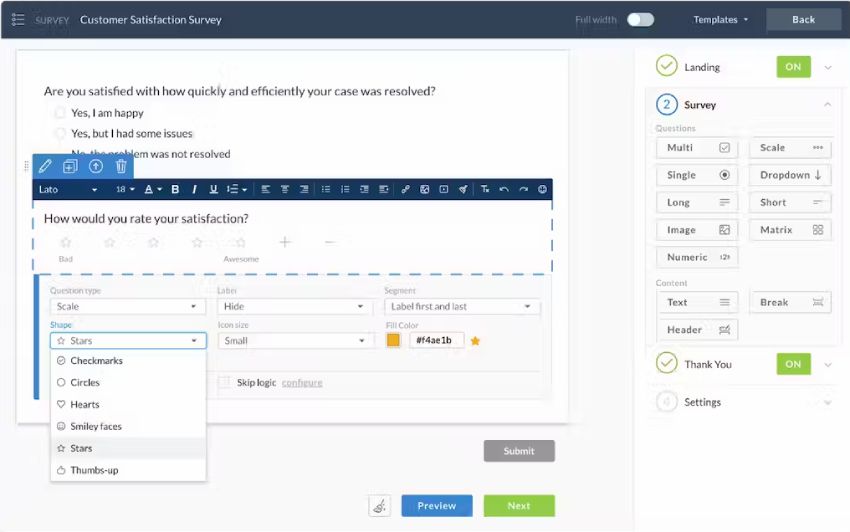
Nextiva features a built-in survey tool. (Source: Nextiva)
Popular business phone solution provider Nextiva allows users to customize and automate customer surveys right within its communication platform. The survey tool features a question bank, which is a collection of prebuilt questions. It has various categories: market research, customer feedback, and event feedback. Nextiva also supports automation, removing the manual work of sending surveys after customer interactions.
Our comprehensive Nextiva review discusses more customer service tools available on the platform. Its monthly subscription fee starts at $30.95 per user for one to four users.
5. Create a Comprehensive Knowledge Base
When relevant information is readily available for agents, they resolve concerns faster and provide the best advice to customers. Using the insights gleaned from your VoC research, come up with an internal knowledge base that includes all the frequently asked questions (FAQs) and concerns from your customers. You can also categorize the inquiries so agents are able to find information easily.
The better option is to use a knowledge base software solution that has built-in search functionality. With this, representatives only need to type keywords to get the information they need.
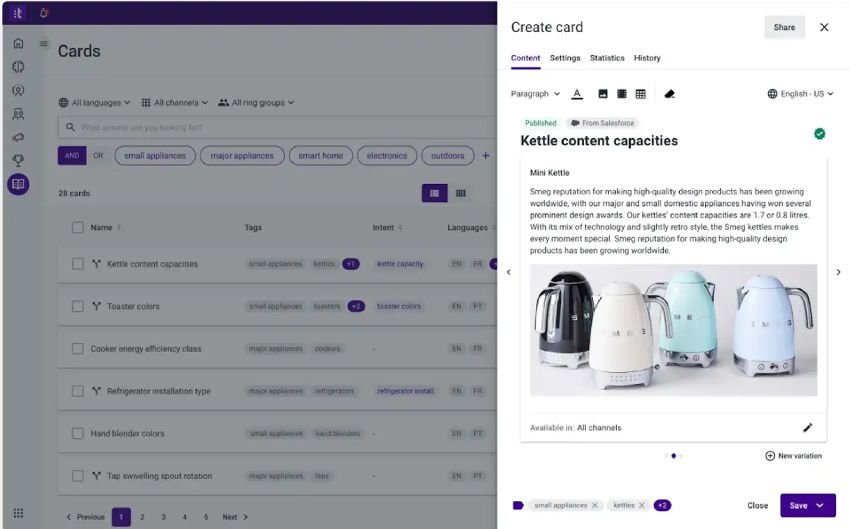
Talkdesk’s content cards help agents provide accurate answers to customer queries. (Source: Talkdesk)
Contact center software Talkdesk has a built-in knowledge management tool that lets you create content cards, which contain information about products and services. They can pop up as on-call recommendations or be accessed through manual search, empowering agents to respond to queries faster and more accurately.
If you’re keen on using this contact center solution, its entry-level subscription rate is $85 per user, monthly. The Agent Assist is available as an add-on to the most expensive package, priced at $145 per user, per month.
6. Make the Customer Relationship Management (CRM) System Accessible
As you offer agents information about products and services, make customer details available as well to speed up answering customer questions. Your chosen CRM system must be easy to navigate, even for new service representatives.
More importantly, keep all information in one platform so that agents won’t have to use multiple apps to get necessary product and customer information. Maximize your call center phone system’s integrations with third-party solutions to reduce app switching. Or, see if the software has a built-in CRM system. In this case, you simply have to import information.
7. Personalize the Experience
Personalization, which forms part of call center customer experience best practices, refers to providing a service tailored to a specific customer’s need. The simplest way to deliver a personalized service is to learn and use the client’s name in the conversation. Maximize your call center system’s caller ID and CRM system to correctly address them by name.
Another way to personalize the experience is to create hyper-detailed profiles on your CRM system. Include as much customer information as possible, including nicknames, occupations, interests, spending habits, and preferred communication channels, so that you can incorporate these into your conversations and build better rapport. Leverage the information about the customer’s previous transactions in your CRM when up- and cross-selling.
8. Offer Self-service Through the Interactive Voice Response (IVR) System
Self-service allows customers to resolve their own concerns without the assistance of a live human agent. It’s faster, thus creating a more pleasant customer experience. Design your IVR system in a way that reflects common customer needs at the beginning of menu options. Configure your call routing and ensure callers are directed to the right departments or agents.
From your VoC research insights, find out which concerns can be automated. For instance, you may allow customers to check their account balance, track orders, make payments, or schedule appointments without speaking to a human representative. Learn more about IVR self-service best practices to beef up your call center operations.
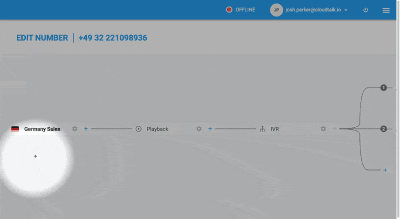
CloudTalk features an intuitive IVR designer. (Source: CloudTalk)
Call center system CloudTalk is equipped with a call flow designer that makes mapping out caller journeys easier. It has prebuilt menu options, including calling a preferred agent, calling a specific group, and dialing an extension. With this IVR, callers are able to direct themselves to their preferred destination even without the help of a live receptionist.
CloudTalk’s subscription plan costs $25 per user, per month. The package includes automatic call distribution (ACD), unlimited call queueing, and call flow designer.
Training Customer Service Representatives
Ensuring that agents are mentally and emotionally prepared to accommodate customer concerns is crucial for call centers, as representatives’ competence contributes to customer satisfaction. As part of call center workforce management best practices, create training programs with these strategies:
9. Create Knowledge, Skills, Abilities & Culture (KSAC) Profiles Before Conducting Training
Determine the knowledge, skills, abilities, and culture (KSAC) call center agents must develop after the training program. This helps you be more intentional in planning your courses and curriculum. Let’s break down what KSAC means:
- Knowledge: Your training must help agents develop mastery of your products and services. If you’re in a niche industry, like healthcare and finance, representatives may need to learn certain terminologies to convey accurate information to customers or specific industry standards to comply with regulations.
- Skills: Improving technical and social skills should be part of the training, including the basics of navigating call center and CRM software solutions and handling customer complaints.
- Abilities: Representatives must develop the ability to adapt to changing customer needs and personalize services. Other agent abilities include empathy and collaboration with team members.
- Culture: Agents must adopt your company’s beliefs, values, and behaviors so they can represent your organization professionally to customers.
10. Use Various Call Center Training Delivery Methods
Remember, different individuals have various learning styles. You’ll sustain agents’ engagement and participation more when you introduce different training delivery techniques. Don’t be stuck on in-person training sessions. Explore these methods:
- Simulations: Place agents in imaginary call scenarios mimicking real-life customer interactions. Configure your call simulation software solution according to the rate of incoming calls you receive frequently or the common types of interactions you handle.
- Videos: Allow remote call center agents to access training materials easily with prerecorded instructional videos. These types of content are highly flexible—you may produce animated videos with a narrative or in-person session recordings.
- Live webinars: Invite an expert in your field to talk about call center best practices. If meeting in person isn’t possible because of the geographic distance among team members, live webinars are the best way to make it happen.
- Competitive games: Turn training courses into games for a more interactive session. For instance, when discussing how to handle customer concerns, list your most bizarre customer complaints along with fake, yet equally absurd inquiries. Ask the agents to guess which ones are legitimate and untrue. Whoever guesses the most concerns wins.
- Written manuals: Provide a written document of all your standards and processes so agents will have a ready reference whenever they need a refresher. Roll out written tests regularly to test agents’ knowledge.
- Podcasts: Produce a series of digital audio content tackling different training topics. Include real-life call scenarios to better illustrate the best practices discussed in the podcast.
11. Find a Competent Call Center Trainer
A call center trainer plays the most important role in equipping call center agents with the necessary skills and knowledge for the job. Aside from teaching the curriculum, their responsibilities also include determining learning goals, analyzing call center statistics, sharing key performance indicator (KPI) reports with company executives, and creating training courses based on agents’ knowledge and skill gaps.
An effective call center trainer is someone who communicates articulately, handles customer complaints and problems with confidence, and inspires agents to perform well. They are knowledgeable about the latest call center technologies and can easily teach how to navigate different solutions, including voice-over-internet-protocol (VoIP) phone systems. They possess data analysis skills with a keen eye on individual and team performance issues.
Monitoring Call Center Performance
To achieve efficient call center operations, managers must look at performance data and adjust strategies accordingly. It must be noted that regular monitoring should be a priority to establish a culture of continuous improvement. Moreover, since customers’ needs and expectations change, strategies should be updated regularly. Implement the call center management best practices below as you assess data:
12. Measure What Matters
There’s an abundance of data in call center software solutions, and it quickly gets overwhelming for teams. To prevent information overload and be more strategic in monitoring KPIs, identify and zero in on what you want to improve based on your goals.
For example, if your high-level objective is to enhance customer satisfaction, one of your subgoals is to reduce customer wait times. In this regard, you must monitor average handle time (AHT) and analyze the call abandonment rate or the number of callers who disconnected from the call before speaking to an agent. Let your goals dictate what to prioritize when looking at metrics.
13. Drill Down Into Customer Moods & Behaviors
Aside from the numbers revealing how your team is performing, explore other analytics tools that show how customers perceive your customer service. Speech analytics evaluates the words uttered in a phone call and organizes them into categories, allowing you to understand which topics matter most to customers.
Voice analytics analyzes speech patterns to uncover the customer’s emotions. This is beneficial for gauging customer satisfaction and identifying sources of frustration. Meanwhile, self-service analytics identifies issues in the IVR system, helping you spot at which point in the journey callers abandon the call. Gain as much insight as you can about customer sentiments and actions from these analytics features to implement data-backed changes in your operations.

RingCentral analyzes the most popular topics in customer interactions. (Source: RingCentral)
RingCentral Contact Center features a robust analytics tool that offers deep insights about customer perceptions. It shows what people are talking about, how long specific conversations last, and which contact issues are frustrating to customers. If you want to try this platform for your call center operations, familiarize yourself with its features by reading our RingCentral Contact Center review.
This artificial intelligence (AI)-powered contact center solution starts at $65 per user, per month, paid annually. This subscription plan already includes real-time and historical reports.
14. Analyze the Most Important Calls
Part of call center quality assurance best practices is looking into 100% of the calls, not just a few randomly selected conversations, as much as possible. This will give you an accurate, holistic view of what’s happening in the call center. Some call center software solutions, powered by artificial intelligence (AI), offer this functionality and alleviate the burden of manually reviewing calls.
But in case your existing platform doesn’t have this feature and reviewing all calls is impossible, the smartest way to go about this is to pick out the most important calls in your business. For example, phone calls with low customer satisfaction survey scores are worth reviewing to know the reasons for unpleasant call experiences.
Choosing a Call Center Software Solution
Your choice of call center platform significantly affects your team’s productivity in handling phone calls. Some solutions have basic call management capabilities, like ACD and IVR, while others have more robust tools, such as queued callback, workforce management, and gamification analytics. It’s important to determine your call center requirements to know which features to look for in a software solution.
On top of identifying specific features, adopt the following strategies for selecting a call center software solution:
15. Gauge the Call Center Platform’s User-friendliness
A user-friendly platform allows agents to access the features they need faster. Moreover, you’ll have little to no downtime when transitioning to a new software solution, as representatives become quickly familiar with the system. To know if the solution you’re eyeing is user-friendly, take advantage of its free trial. If you’ve used a call center platform in the past, trying out the solution on your own should be fine.
However, if this is your first time using a solution, request a demo from providers. As you gain access to the platform, try out the features most critical to your call center operations first. Involve team members in this process to gauge how easy these tools are to use.
16. Find a Platform That Integrates With Existing Business Tools
Along with a call center solution, you may be using other business apps like a help desk, a CRM, and social media platforms to communicate with customers effectively. The ideal setup is for all these tools to be in one interface so that agents have access to all the information and communication features they need while talking to customers.
See if the call center platform you’re eyeing integrates with the apps you already use. Better yet, find a software solution with a wide range of third-party integrations.
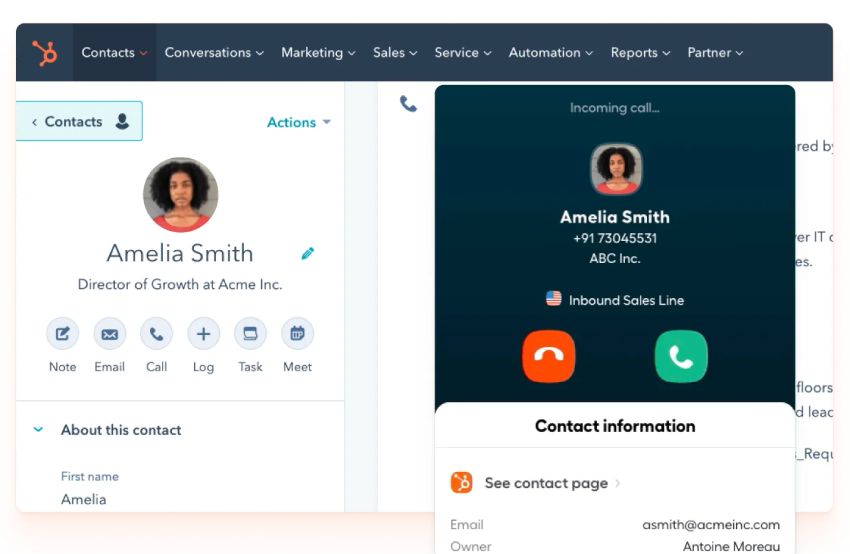
Aircall works with the CRM platform HubSpot. (Source: Aircall)
Aircall is a call center system that integrates with several popular business solutions. It works with CRM tools such as Salesforce, HubSpot, Microsoft Dynamics, and Pipedrive. With customer information displayed during a live phone call, agents are able to properly address customers by name, see previous transactions, and understand concerns better.
Subscribe to the phone system for $40 per user, monthly, for a minimum of three users. This subscription plan offers access to over a hundred integrations, as well as application programming interfaces (APIs) and webhooks.
17. Check Whether the Call Center Platform Is Scalable
As your call center operations expand, you need a platform that grows with you. There should be no hassle or hefty costs when adding more team members to your account or handling larger volumes of calls. To determine scalability, ask the vendor these questions:
- Can I add and remove users instantly?
- How much is the rate per agent monthly? Are there discounts for volume users?
- Do you offer unlimited minutes?
- Do you support unlimited concurrent calls?
- Can your system handle high-volume calls?
- What’s your uptime guarantee?
Frequently Asked Questions (FAQs)
First, try to stay calm. You’ll be able to handle the situation in a more logical way when you’re not overcome by emotions. While it’s difficult to understand an angry customer, try to practice active listening as much as you can. By knowing what exactly their concern is, you’ll be able to come up with relevant solutions that would resolve issues faster.
The glad-sure-sorry technique is a communication strategy for handling negative customer feedback. “Glad” means acknowledging complaints, “Sure” involves telling customers you’ll find a solution for their problem, and “Sorry” entails recognizing the inconvenience the customer experienced.
If a customer is disrespectful toward you even after offering solutions or telling them that you’re not able to accommodate their request, end the conversation politely and professionally. Here are some statements you can use:
- “I completely understand the inconvenience you experienced, and these are the solutions we can offer at the moment. Is there anything else I can help you with?”
- “I took note of your suggestion and request, but we cannot provide that at the moment. We’ll update you when our team comes up with a solution.”
Bottom Line
When improving communication operations, focus on call center best practices that help boost customer satisfaction, provide effective agent training, and track call center performance regularly. Selecting the right call center software solution for your needs can help you implement these best practices.
Ultimately, both clients and agents benefit from efficient processes. Keep abreast of the latest contact center statistics to be familiar with effective customer service strategies and new technologies in the market.